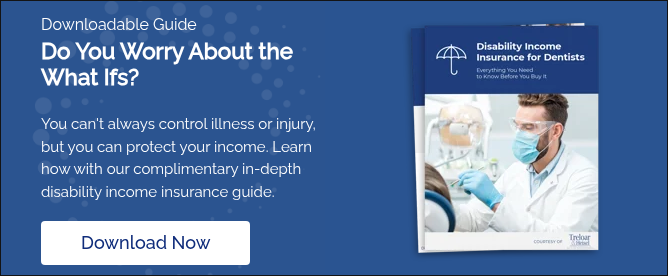Posted by D. Scott Fehrs, ChFC® on Jun 30, 2021 9:00:00 AM
When you work with your hands all the time, it's inevitable that you'll experience some pain, stiffness, or discomfort sometimes.
But you still have work to do, and taking good care of your hands is a part of that job. Hand pain is common in the dental profession, but you'll want to make sure it's nothing serious, and work to alleviate the little issues that can come up from time to time. Sometimes, hand pain indicates a bigger problem, like carpal tunnel or osteoarthritis. At other times, it's just from overuse.
Treloar & Heisel can't (and won't) treat, diagnose, or advise on any medical condition to do with hand injuries, pain, or related concerns. If you have worries about pain or extreme discomfort in your hands or anywhere else, it's very important to talk with your medical provider. For the original sources of the information in this article, please see the “Sources” section at the bottom of this blog post.
When you have everyday discomfort such as cramps and other simple issues, there are options to help. With the right hand exercises for dentists, you may be able to reduce minor pain and help maintain a good range of motion. Here are some exercises.

Exercise 1: Making a Fist
To perform this exercise, make a fist and squeeze it, then stretch until you feel tightness (but not pain). You want to really stretch the fingers and make a strong fist, but you don't want to do anything that's going to cause you more discomfort. Feeling the stretching of the muscles and tendons isn't the same thing as feeling pain. This helps strengthen the hands and fingers, and can provide relief from discomfort. It can also increase the range of motion for you, so you can do more without feeling pain in your hands.
While making a fist is a pretty easy thing to do, many people are surprised at how much it stretches their hands and gives them some increased range of motion. If you do this exercise several times a day, such as in between patients and while on breaks, you may find that your hands start to feel a lot better, and you're more prepared for the care your patients really need from you in the future. That's a great way to accomplish more and feel good about your abilities to get more done for the people who rely on you.
Exercise 2: Stress Ball
Squeezing a stress ball can help improve grip and finger strength. This may help your grip stay consistent, steady and "feel right" as you're working. That reduces the risk of dropping tools, and helps you feel more confident. When you're looking into hand exercises for dentists, some of the options are those that can be done easily, almost anywhere. It's not difficult to carry a stress ball, or to have a few around in convenient locations. That way you can exercise with them frequently.
A stress ball isn't expensive, either, and you can get them in different colors and "feels." Some are firmer than others, and some are gel-based. If you're not sure which kind of stress ball might be right for you, purchasing several of them and trying them out can be a good way to make sure you get one you like. Don't settle for an option that doesn't give you the quality you're looking for. With so many options, you'll be able to find a great stress ball and hopefully get your hands feeling good and free of discomfort again.
Exercise 3: Thumb Stretch & Flex
For this exercise, you'll start with an open palm and all of your fingers touching. Then, expand your thumb to make an "L" shape, and then go back to the starting position. After that, start with all the fingers and thumb spread, and move the thumb to connect it to the first knuckle of your pinky finger. These stretch and flex options are among the easiest hand exercises for dentists. They don't require a lot of effort, but they're convenient and can be done anywhere without any kind of equipment.
When stretching, hold the stretch for a few seconds and make sure you fully complete it. It's very important not to rush through these exercises. They should be done with precision, and should feel deliberate. That makes them easier for you to focus on, and helps you get more value out of them. They can be done anywhere, so you can use the time between patients to try to keep your hands stronger and reduce the pain you're feeling in them, too.
Exercise 4: Mold Clay
With a lump of clay or other soft, malleable substance, mold and reset it as much and as often as you need to. This may improve the general dexterity of your fingers, along with your strength, grip, and feel. When you have good finger dexterity, you can more easily manipulate the tools you have to use. That skill provides a better experience for your patients and raises your confidence level. Additionally, it can make your job easier and more efficient, which benefits everyone involved with your practice.
Protect Yourself and Your Patients
Hand exercises for dentists are only one of the many ways you can protect yourself and your well-being as you move through your career. Another way to protect yourself and your patients is by having appropriate kinds of insurance. If you need disability income insurance to provide extra protection for your dental practice, we can help. This insurance will give you an added level of protection in case something should happen.
If you're finding that hand exercises aren't enough, and you're feeling a lot of pain or discomfort in your hands, it's possible you could end up needing medical intervention or a condition is causing the problem. That could even mean an inability to continue your work, at least for a period of time. The right kind of coverage can help give you peace of mind whenever a situation like that arises.
Sources
https://www.posturite.co.uk/help-advice/useful-resources/learning-guides/workstation-exercises/finger-wrist-forearm-stretches
https://www.healthline.com/health/chronic-pain/wrist-and-hand-stretches
Treloar & Heisel and Treloar & Heisel Property and Casualty are divisions of Treloar & Heisel, LLC.
Insurance products are offered through Treloar & Heisel, LLC.
Treloar & Heisel, LLC. does not offer medical advice. This content is intended for general information purposes and should not be construed or relied on as advice. Please consult with a medical professional.
21-081


